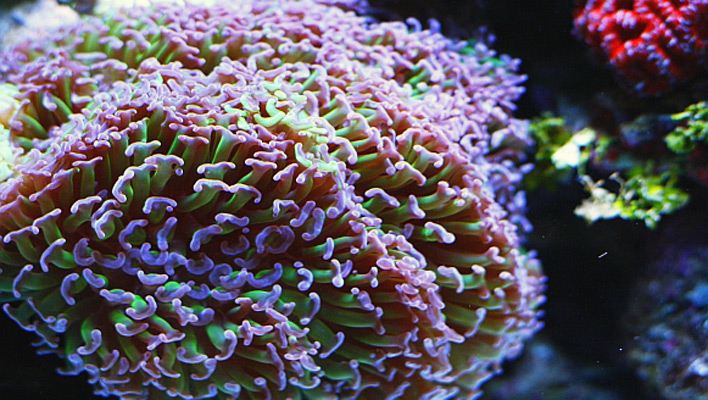At a casual glance, corals would appear to be an inoffensive lot, generally espousing a “live-and-let-live” philosophy. After all, when you’re firmly affixed to the substrate, how much trouble can you really cause for your neighbors?
Plenty, as it turns out! Corals and other sessile invertebrates may seem harmless, but they actually take aggression to such a diabolical level that they make even the most pugnacious fish look like Ghandi with fins. They’re just much more sneaky and insidious about it.
Depending on the species and particular circumstances, corals may employ one or more of the following aggressive mechanisms:
- Rapidly overgrowing neighboring invertebrates—i.e., actually growing directly onto the neighboring colony or extending over it and preventing it from receiving life-sustaining light
- Stinging neighbors with nematocyst-laden tentacles
- Extruding digestive organs (called mesenterial filaments) and essentially digesting the tissues of adjacent corals
- Exuding toxic chemicals (e.g., terpenoids) into the water to kill neighboring corals or impede their growth
What can reefkeepers do to counteract these hostile tactics?
#1 Research before you buy
We’ve advised this time and time again here at Saltwater Smarts, but it bears repeating. A little modest research on the characteristics of different corals will reveal all kinds of vital information regarding their relative aggressiveness/noxiousness, for example the fact that Sarcophyton leather corals are notoriously toxic and that various Euphyllia spp. corals are known to produce long, stinging “sweeper” tentacles. Such details must be taken into account when choosing which species to combine and how to situate them in your tank.
#2 Space them out
When placing specimens, allow more room between them than you think they’ll eventually need. If the tank looks sparse initially, that’s okay. It’s better to have a smaller number of specimens with plenty of room to stay clear of each other’s tentacles than to have a larger number growing on top of one another and in a state of constant warfare.
#3 Isolate rapid-spreading corals
Corals/polyps that form encrusting mats and grow rapidly outward onto adjacent substrates, such as green star polyps and certain zoanthids, may need to be isolated to a single, separate rock—an island, if you will—to keep their growth in check and prevent them from irritating or overgrowing cnidarian neighbors.
#4 Maximize water movement
Brisk, turbulent water movement, which is beneficial in many reef-aquarium settings anyway, will help prevent toxic chemical compounds from concentrating around any particular specimen. Keep in mind, however, that not all sessile invertebrates appreciate a high level of current. Some, such as Discosoma spp. mushroom polyps, prefer very low levels of water movement.
#5 Employ a protein skimmer, chemical filtrants, and copious water changes
Vigorous protein skimming and chemical filtration with activated carbon will help remove/adsorb the byproducts of coral chemical warfare. And, of course, you can add the removal/dilution of these toxins to the many virtues of regular partial water changes.




When hammer corals mature, they can wreck havoc on neighboring corals
http://i258.photobucket.com/albums/hh270/urchsearch/2014-10-22121701_zpsf288044e.jpg
If you think hammer corals are bad, you should see what table saw corals can do to their neighbors!
Do you recommend shorter periods of water movement or longer continuous periods in two alternate directions? I have 2 korallias in my 55gal reef?d
There are definitely varying opinions on this, but we advocate providing continuous random, turbulent water movement around corals (at a level of intensity appropriate to the species, of course). That typically requires some experimentation with the position of powerheads, filter return nozzles, etc. so their outputs intersect in the water column and/or deflect and scatter off the tank glass or objects in the aquarium. Hope that helps!
Thanks. I play around with them and typically try ro intersect in the middle of the tank near the over flow box.